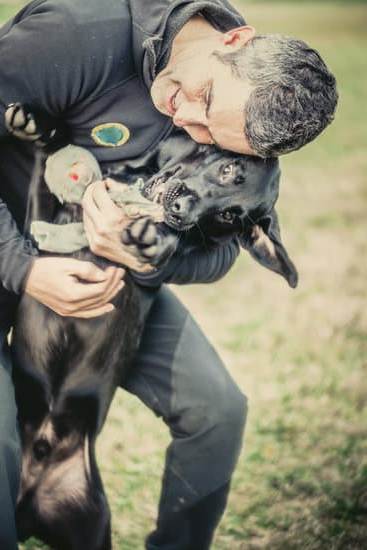How are dogs trained to detect drugs? Drug detection dogs play a crucial role in law enforcement and border control, aiding in the detection of illegal substances and helping to prevent the spread of drugs. These highly skilled canines are trained to sniff out various narcotics, including heroin, cocaine, and methamphetamine, making them invaluable assets in the fight against drug trafficking.
The use of dogs for detecting drugs has a long history, dating back to ancient times when canines were first utilized for their keen sense of smell. Over the years, the practice has evolved significantly, with advancements in training methods and technology enhancing the effectiveness of drug detection dogs.
A dog’s incredible sense of smell is key to its ability to detect drugs. With over 300 million scent receptors in their noses (compared to about 5-6 million in humans), dogs are able to pick up even trace amounts of odors associated with narcotics. This remarkable olfactory capability allows them to locate hidden contraband with remarkable accuracy, making them an indispensable tool for law enforcement agencies and border security.
The History of Drug Detection Dogs
Drug detection dogs have been an integral part of law enforcement and border control for decades, playing a crucial role in identifying and intercepting illegal drugs. The history of using dogs to detect drugs dates back to the early 20th century, when canines were first recognized for their remarkable olfactory abilities. Over time, the practice has evolved significantly, with advancements in training techniques, selection criteria for dogs, and the understanding of canine scent detection.
In the early years of drug detection dog use, it was primarily focused on detecting marijuana and heroin. As drug trends shifted and new substances emerged, such as cocaine and methamphetamine, the training and deployment of drug detection dogs also adapted to target these illicit substances. Today, drug detection dogs are trained to identify a wide range of narcotics, including synthetic drugs that pose significant challenges to law enforcement agencies.
The evolution of using dogs to detect drugs has also been influenced by scientific developments in understanding canine scent detection. Research has shown that a dog’s sense of smell is incredibly sensitive and complex, with the capability to detect minute traces of odors.
This has led to more sophisticated training methods that harness a dog’s natural scent discrimination abilities. By understanding how are dogs trained to detect drugs, law enforcement agencies can more effectively utilize these animal companions in the ongoing battle against illicit substances.
| Drug Detection Dog | Evolution |
|---|---|
| Cocaine | Improved training techniques |
| Synthetic Drugs | Adaptation to new substances |
| Marijuana/Heroin | Initial focus of detection |
Canine Scent Detection
The Science Behind a Dog’s Sense of Smell
A dog’s sense of smell is truly remarkable, with estimates suggesting that they can detect scents at concentrations nearly 100 million times lower than humans. This incredible ability is due to their highly developed olfactory system, which includes a large surface area in their nasal cavity and a specialized organ called the vomeronasal organ. These features allow dogs to not only detect scents but also to differentiate between them, making them invaluable for tasks such as drug detection.
The Role of Scent Detection in Drug Detection
When it comes to detecting drugs, a dog’s sense of smell is instrumental in locating even small amounts of controlled substances. Dogs are trained to identify specific odors associated with various drugs, including marijuana, cocaine, heroin, and methamphetamine. Their ability to pinpoint these scents allows law enforcement to locate hidden drugs quickly and efficiently, making them an essential tool in the fight against illegal drug trafficking.
How Are Dogs Trained to Detect Drugs
The training process for drug detection dogs involves harnessing their natural scent detection abilities and honing them for a specific task. Dogs undergo rigorous training regimens that focus on scent recognition, alert cues, and obedience. They are exposed to the scent of different drugs during training sessions and are taught to associate those scents with a specific response or behavior.
Through positive reinforcement techniques, such as rewards or playtime, dogs learn to indicate the presence of drugs when they encounter the corresponding odor. As a result of this intensive training, drug detection dogs become highly reliable assets for law enforcement agencies in combating drug-related crimes.
Selecting the Right Dogs
When it comes to selecting the right dogs for drug detection training, certain breeds and characteristics are more suitable for this specialized task. One of the key factors in choosing a dog for drug detection work is their sense of smell.
Breeds that have a highly developed sense of smell are typically preferred, as this is crucial for detecting the presence of drugs. Some of the most commonly used breeds for drug detection work include Labrador Retrievers, German Shepherds, Belgian Malinois, and Springer Spaniels.
In addition to a strong sense of smell, dogs chosen for drug detection training should also possess high levels of energy and play drive. This is because drug detection work requires intense focus and motivation on the part of the dog. They need to be able to remain alert and engaged during long periods of searching and be motivated by their reward system when they successfully detect drugs.
Furthermore, dogs selected for drug detection training should exhibit a strong willingness to work and be highly trainable. This means they should be responsive to commands and have a desire to please their handlers. The ability to quickly learn and retain scent recognition is also an important characteristic when selecting dogs for drug detection training.
Overall, the process of selecting the right dogs for drug detection training involves considering a combination of breed traits, personality characteristics, and specific behavioral qualities that make them well-suited for this demanding role.
| Characteristic | Relevance |
|---|---|
| Sense of Smell | Crucial for detecting drugs |
| Energy and Play Drive | Necessary for maintaining focus during searches |
| Trainability | Important for learning scent recognition and following commands |
The Training Process
Drug detection dogs undergo a rigorous training process to develop their ability to detect drugs with precision and accuracy. This process involves several key components that are essential for preparing these canines for real-life detection scenarios. From scent recognition to alert cues and obedience, the training regimen is designed to harness the natural abilities of dogs and enhance their skills through consistent practice and reinforcement.
Scent Recognition
One of the fundamental aspects of training drug detection dogs is teaching them to recognize specific drug odors. Dogs have an incredibly powerful sense of smell, and they are capable of detecting even trace amounts of drugs. During training, dogs are exposed to various drug scents in controlled environments, gradually learning to associate each scent with a specific action or alert cue.
Alert Cues
Once a dog has been trained to recognize the scent of a particular drug, they must be taught how to communicate their discovery effectively. This is where alert cues come into play. Depending on the training methods used, dogs may be trained to signal the presence of drugs by sitting down, barking, or using other visual or auditory indicators. Consistent reinforcement and positive reinforcement are crucial in ensuring that these alert cues are reliable in real-world situations.
Obedience
In addition to developing their scent recognition and alert cues, drug detection dogs also undergo obedience training to ensure they can perform their duties effectively under various circumstances. This includes following commands from their handlers, maintaining focus during searches, and remaining calm and controlled in high-pressure environments such as airports or border crossings. Through intensive obedience training, these dogs become valuable assets in law enforcement efforts aimed at combating the illegal drug trade.
Legal and Ethical Considerations
Drug detection dogs play a vital role in law enforcement and border control, helping to locate illegal drugs and prevent their distribution. However, the use of these highly trained canines raises important legal and ethical considerations that must be carefully navigated.
One of the primary concerns surrounding drug detection dogs is privacy. When used in public spaces or at transportation hubs, these dogs have the potential to intrude on individuals’ privacy rights. This is particularly true when considering that drug detection dogs may create false positives, leading to unwarranted searches of innocent individuals. It is essential for law enforcement agencies to strike a delicate balance between using drug detection dogs effectively and respecting individuals’ privacy rights.
In addition to privacy concerns, proper handling of drug detection dogs is crucial for ensuring their welfare and effectiveness. Trained handlers must understand the importance of keeping the dog’s training up to date, maintaining proper care for the animal, and preventing handler bias from influencing search results. The relationship between handler and dog is also critical, as clear communication and trust are necessary for successful drug detection operations.
When considering legal and ethical issues related to drug detection dog usage, it is important for law enforcement agencies to evaluate their policies and procedures regularly. By doing so, they can ensure that these valuable assets are utilized in a manner that respects individual rights while still being effective in identifying illegal drugs.
- Privacy concerns
- Proper handling of drug detection dogs
- Evaluating policies and procedures for dog usage
Real-Life Examples
Drug detection dogs have made a significant impact on law enforcement efforts, contributing to countless successful operations in which illegal drugs have been intercepted and confiscated. One such example is the case of a drug detection dog named Max, who was responsible for uncovering a major drug smuggling operation at a border checkpoint.
Max’s keen sense of smell allowed him to detect narcotics hidden within a vehicle, ultimately leading to the arrest of several individuals involved in the illicit trafficking scheme.
Another real-life example that highlights the effectiveness of drug detection dogs is their use in combating drug distribution within correctional facilities. By conducting regular searches with the assistance of trained canines, prison staff have been able to prevent the introduction of illegal substances into these secure environments. The presence of these highly trained dogs serves both as a deterrent and as a means of proactively addressing potential security threats posed by drugs within the prison system.
Moreover, drug detection dogs have also played a crucial role in intercepting large quantities of narcotics being transported through commercial channels. In one notable instance, a K9 unit successfully uncovered a shipment of illicit drugs concealed within a cargo shipment at an international airport.
This seizure not only prevented these drugs from reaching their intended destination but also disrupted the activities of organized crime groups involved in drug trafficking. These real-life examples demonstrate the invaluable contributions that drug detection dogs make to law enforcement efforts on a daily basis.
- Successful interception at border checkpoints
- Prevention of drug distribution within correctional facilities
- Interception of illicit cargo shipments at international airports
Future Developments
In conclusion, the use of drug detection dogs has proven to be an invaluable asset in law enforcement and border control efforts. By harnessing the incredible sense of smell that dogs possess, authorities have been able to detect and intercept large quantities of illegal drugs, leading to significant disruptions in drug trafficking operations. The history of drug detection dogs shows how the practice has evolved over time, becoming more sophisticated and effective with advancements in training techniques and technology.
Looking ahead, there is great potential for further developments in drug detection dog training. With ongoing research into canine scent detection and behavior, we can expect to see improvements in the selection process for suitable breeds and individual dogs. Additionally, new technologies such as electronic nose devices may complement the work of drug detection dogs, enhancing their capabilities and accuracy in identifying illicit substances.
As we continue to rely on drug detection dogs as a critical tool in combating the flow of illegal drugs, it is essential to address legal and ethical considerations surrounding their use. Striking a balance between privacy concerns and public safety will be crucial in ensuring that the deployment of drug detection dogs remains ethical and effective.
By staying informed about these issues and embracing potential advancements in training and technology, we can look forward to even greater success in utilizing drug detection dogs for years to come.
Frequently Asked Questions
How Accurate Are Drug Sniffing Dogs?
Drug sniffing dogs can be incredibly accurate in detecting drugs, with success rates as high as 95 percent. However, accuracy can be affected by factors such as handler cues and environmental conditions.
How Long Does It Take to Train a Dog to Find Drugs?
The length of time it takes to train a dog to find drugs can vary depending on the dog’s breed, temperament, and the complexity of the training program. On average, it can take anywhere from 6 to 14 weeks to train a drug detection dog.
How Do I Train My Dog to Be a Sniffer Dog?
Training a dog to be a sniffer dog involves using positive reinforcement techniques to teach them how to detect the scent of drugs. This often includes imprinting them on specific drug odors and teaching them to indicate when they find the scent. Consistent repetition and reward are key in this training process.

Welcome to the blog! I am a professional dog trainer and have been working with dogs for many years. In this blog, I will be discussing various topics related to dog training, including tips, tricks, and advice. I hope you find this information helpful and informative. Thanks for reading!





